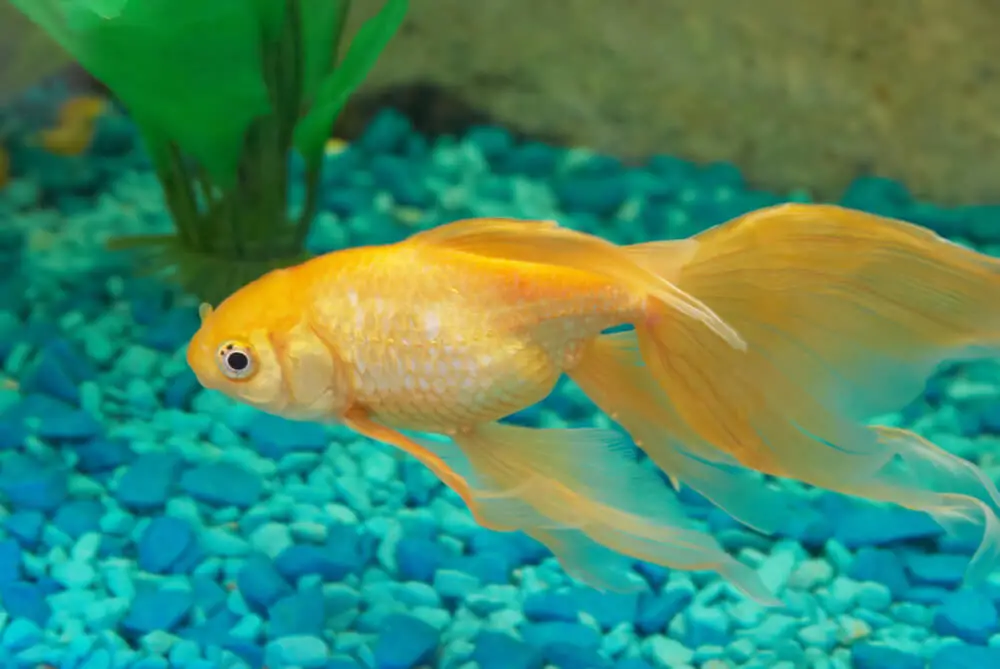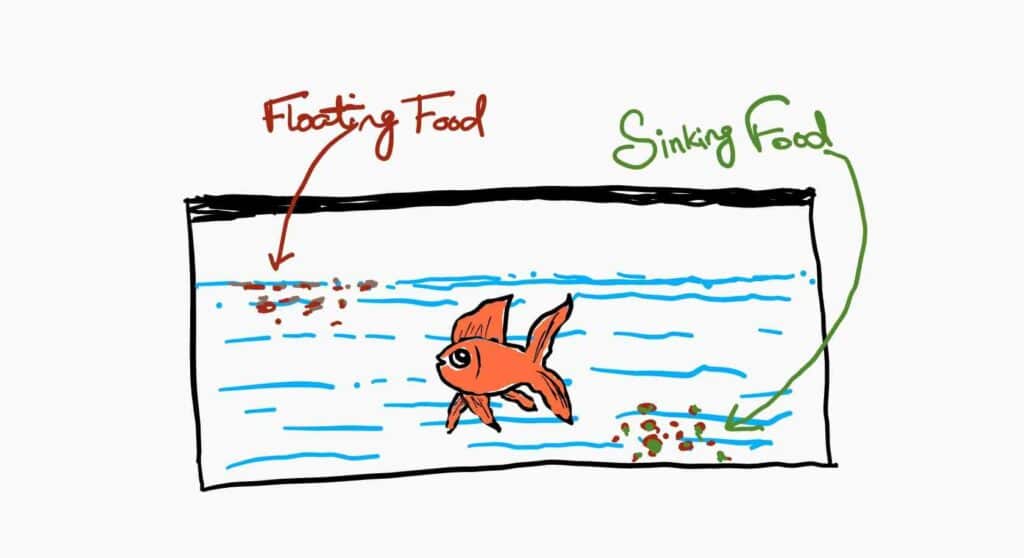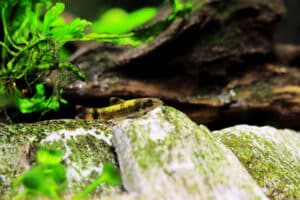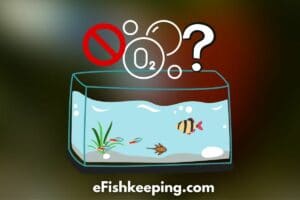If you’re a goldfish owner or just considering getting one, you may have heard that these finned friends are bottom feeders. But what does that mean exactly, and are goldfish really a bottom feeder? Read on to explore more!
What Is The Meaning Of Bottom Feeders? A Quick Overview For Beginners
In the aquarium hobby, “bottom feeder” refers to a type of aquatic animal that feeds on or near the bottom of the tank. These animals are often scavengers, feeding on dead plants and other food debris collected at the tank bottom.
Examples of bottom feeders commonly kept in aquariums include catfish, loaches, goldfish. Some invertebrates, such as snails, are also considered bottom feeders.
Bottom feeders actually play a crucial role in the ecosystem by taking up excess nutrients and keeping the water clean. Although they are not a replacement for water changes or filtration, their contribution in cleaning the tank can’t be ignored.
But remember:
Bottom-dwelling fish like a goldfish, have a knack for digging and pulling at things in the tank.
While this might be amusing to watch at first, it can quickly become a problem if your plants and decorations start floating around the tank.
But fear not! There’s an easy solution to this common aquarium issue: simply tie them down to a rock or attach a heavy object at the plant base. This will help keep them in place and prevent your goldfish from causing a floating frenzy.
Are Goldfish Really Bottom Feeders?

Goldfish are bottom feeders but their feeding patterns aren’t strictly like a bottom feeder fish as they can eat from anywhere in the tank.
A strict bottom feeder fish has a typical mouth structure (curved downward as in clown loaches, cory catfish) that is more suitable for feeding in bottom areas of the tank.
On the other hand, the mouth structure of Goldfish has a round opening surrounded by thin, flexible lips. This allows them to suck up food from preferably the bottom of their tank or pond but not limited to not only the bottom surface.
They can also come near the top of the tank in the search of food – as well as grasp and manipulate small bits of food.
Every time you’d drop in a little bit of food, chances are they would go absolutely nuts trying to gobble it all up. And when it comes to eating – these fish hardly care for the location of the tank!
So it’s normal if your goldfish is feeding from the top portion or anywhere else in the tank (as long as they are healthy).
Floating Food Vs. Sinking Food For Goldfish: Which One To Choose?

| Floating Food: | Sinking Food: |
| Advantage: Easy to maintain, just toss the food in the tank and goldfish eats it. Waste accumulation is less unless overfed. | Advantage: Naturally beneficial for goldfish because it suits their bottom feeding style. Also, there’s no chance of issues like swim bladder problems. |
| Disadvantage: Risk of giving rise to swim bladder issue in goldfish because they can gulp air while feeding from the surface. | Disadvantage: Makes cleaning and maintenance tasks a bit challenging because food can get trapped inside the substrate and gravels. |
1. Go for sinking food alone:
- If your goldfish tends to have problems with buoyancy and difficulty in swimming due to swim bladder issues.
One type of food that can be particularly helpful for goldfish is sinking pellets, which are formulated to sink to the bottom of the tank rather than floating on the surface.
There are a few reasons why sinking pellets can be a good choice for goldfish. For one, they can help prevent goldfish from sucking in air while feeding, which can lead to buoyancy and swim bladder issues.
2. Go for floating food alone:
- If you have been giving it to your goldfish and haven’t experienced any issues, and your goldfish is fit and healthy.
Goldfish, like other fish, have a natural tendency to gulp air while feeding, especially when they are eating foods that float on the water’s surface. If they consume too much air, it can lead to an enlarged belly – and leading to conditions like swim bladder disease.
The swim bladder is a small, air-filled organ located in the abdominal cavity of fish. It helps to control the fish’s buoyancy and allow them to swim easily in the water.
However, if a goldfish consumes too much air while feeding, it can cause the swim bladder to become enlarged or distorted, leading to problems with buoyancy and swim coordination. This can be especially problematic for fancy goldfish, which are known to be prone to swim bladder issues.
To prevent swim bladder problems in goldfish, it’s important to be mindful of their feeding habits and avoid offering foods that are likely to cause them to gulp air.
Sinking pellets are a good choice for this reason, as they sink to the bottom of the tank. Also it’s a good idea to provide a varied diet to ensure that your goldfish are getting all the nutrients they need.
3. (Recommended) Go For A Combination [Floating + Sinking food along with other food to give a varied diet]
- If you’ve trouble deciding which option to choose, it’s best to feed them a combination of both foods. Offering a variety of food ensures the goldfish gets all the nutrients it needs to thrive well in the tank.
It’s no secret that goldfish have a huge appetite, and it’s not uncommon for them to get a bit excited when it’s feeding time.
However, if you have a lot of goldfish in the same tank, this excitement can lead to competition for food, and sometimes, this can result in your fish gulping air from the surface while they feed.
But don’t worry – there’s an easy solution to this problem! By offering a mix of floating and sinking foods, you can help reduce competition for food and encourage your goldfish to eat more calmly.
Floating foods should be offered in moderation and should not be the primary source of nutrition for your fish.
A varied diet that includes a mix of floating, sinking, live, and frozen foods, along with some vegetables is generally the best approach for maintaining the overall health and well-being of your goldfish.
Recommended Read: Do Goldfish Sleep? (How, Signs, & What To Do)
What Is The Best Bottom Feeder To House With Goldfish?
If you’re a goldfish owner looking to add some variety to your tank, you may be considering adding a bottom-dwelling fish like the Dojo Loach.
These slender fish are known for their energetic, playful personalities. They are also excellent scavengers, which makes them an excellent choice for helping to keep your goldfish tank clean and tidy.
So, what should you consider if you’re thinking about keeping dojo loaches with your goldfish? Here are a few things to keep in mind:
Tank Size: Dojo loaches are active fish and will need plenty of space to swim and explore. As a general rule, you should aim for a tank that is at least 20 gallons for a single dojo loach.
Water conditions: Dojo loaches are generally quite hardy and can tolerate a wide range of water conditions.
Their temperature and pH requirement requirements for both fish fall in almost the similar range as you can see in the following chart.
| Fish: | Temperature: | pH: |
| Goldfish | 68 °F – 74°F | 6.5 – 7.5 |
| Dojo Loach | 68°F – 72°F | 6.0 – 8.0 |
Just be sure to monitor your water parameters regularly and make any necessary adjustments to ensure that your dojo loaches are comfortable and healthy.
Related Read: Do Goldfish Need A Heater? [A Complete Temperature Guide]
Diet: Dojo loaches are omnivorous (just like the Goldfish) and will benefit from a varied diet that includes both plant and animal matter.
Overall, dojo loaches make excellent tank mates for goldfish and can help to create a more diverse and balanced ecosystem in your tank.
Just be sure to provide them with the proper care and attention, and you’ll be well on your way to creating a happy and healthy home for your dojo loaches and goldfish.
Related FAQs: Clearing Up Any Remaining Confusions!
1. Can Goldfish Survive On A Diet Only Of Sinking Food?
While goldfish can certainly survive on a diet that includes some bottom-dwelling foods, it’s important to remember that they are omnivores and need a varied diet to thrive.
It’s generally a good idea to offer a mix of commercial pellets or flakes, as well as fresh or frozen vegetables and small live or frozen foods. This will help ensure that your goldfish gets all the nutrients it needs to stay healthy and happy.
2. Is It Normal For Goldfish To Spend A Lot Of Time At The Bottom Of The Tank?
It’s definitely normal for goldfish to spend some time at the bottom of the tank, especially if they are foraging for food.
However, if you notice your goldfish spending an unusual amount of time at the bottom, or if it seems lethargic or inactive, it could be a sign of illness or poor water quality.
3. Why Is Goldfish A Bottom Feeder?
One of the easiest ways to tell a goldfish is a bottom feeder is to watch its feeding habits.
If it spends a lot of time at the bottom of the tank, sifting through the substrate or rooting around for bits of food, it’s likely a bottom feeder.
4. What Do Goldfish Typically Eat?
Goldfish are omnivores, which means they will happily munch on a wide variety of foods. In the wild, they might munch on insects, plant matter, and small crustaceans.
In captivity, they can be fed a mix of commercial goldfish pellets or flakes, as well as fresh or frozen vegetables and small live or frozen foods like brine shrimp or daphnia.
Wrapping Up
So, in short: goldfish are bottom feeders, because they are capable of feeding on the bottom of the tank and will often forage for bits of organic matter and other debris.
However, they don’t exhibit bottom feeding behavior strictly since they can feed from anywhere in the tank where they find food.
It is good to offer them a varied diet and just be sure to provide them with a diet that is appropriate for their size and species.
Finally, don’t forget to remove any uneaten food or debris from the tank to help keep the water clean.
Recommended Read: Are Your Goldfish Blind? Signs, Causes, Prevention
Hi! I’m Praveen Ghoshal, the founder of eFishkeeping.com. Inspired by my Dad, I got interested in fishkeeping when I was a kid. Since then, I have been involved with this hobby. Currently, I have 3 fish tanks at our home, and I enjoy this hobby with my full family. Read more about me here.







![Do Neon Tetras Die Easily? [Here’s The Truth!] do-neon-tetras-die-easily](https://efishkeeping.com/wp-content/uploads/2023/03/do-neon-tetras-die-easily-300x200.jpg)
